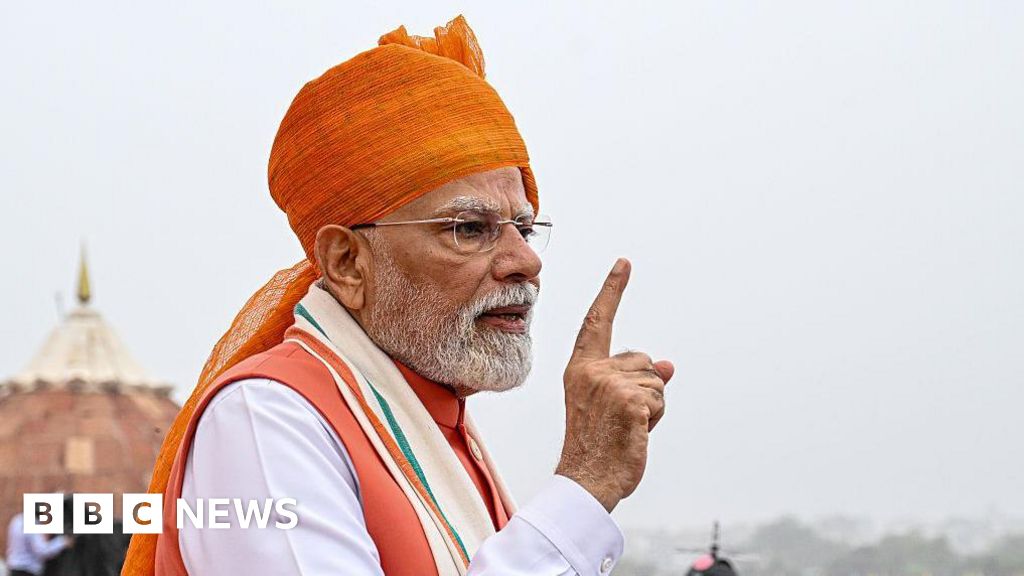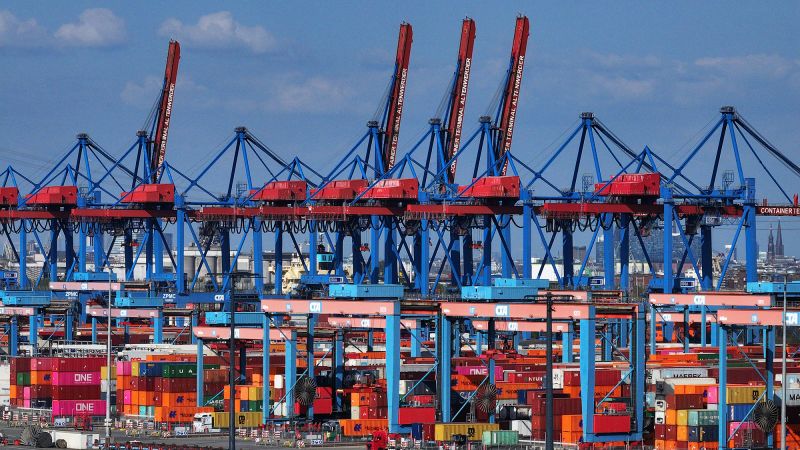US-India Trade War Escalates

Introduction
The relationship between the United States and India has been a topic of heated discussions in recent years, with both countries trying to navigate their economic and political ties. However, the latest move by the US has caused a significant strain on the relationship as tariffs on Indian goods have escalated to 50%. This decision, made by the Trump administration, has come as a surprise to many and has been met with strong opposition from India's government. This move is seen as a retaliatory measure towards India's purchase of Russian oil.
Key Details
The recent decision to impose additional levies on Indian goods by the US has brought the tariff rate to one of the highest in the world. This has resulted in a significant increase in prices for Indian goods entering the US market, making it difficult for Indian businesses to compete. The move has caused a ripple effect in the Indian economy, with many businesses struggling to survive. The Modi government has been pushing for a reduction in tariffs, but this latest decision by the US has made it even more challenging for India to continue its trade with the US.
Impact
The escalation of tariffs by the US on Indian goods has not only affected the relationship between the two countries but also has a significant impact on India's economy. With the increasing tariffs, Indian businesses are facing a tough time in selling their products in the US market, which has been a
About the People Mentioned
Donald Trump
Donald John Trump, born June 14, 1946, in Queens, New York, is an American businessman, media personality, and politician. He graduated from the University of Pennsylvania’s Wharton School in 1968 with a degree in economics. In 1971, he took over his family’s real estate business, renaming it the Trump Organization, through which he expanded into building and managing skyscrapers, hotels, casinos, and golf courses. Trump gained widespread fame as the host of the reality TV show *The Apprentice* from 2004 to 2015, which helped establish his public persona as a successful entrepreneur. Trump entered politics as a Republican and was elected the 45th president of the United States, serving from 2017 to 2021. His presidency was marked by significant policy actions including tax cuts, deregulation, the appointment of three Supreme Court justices, renegotiation of trade agreements (notably replacing NAFTA with the USMCA), and a focus on immigration control including border wall expansion. He withdrew the U.S. from international agreements such as the Paris Climate Accord and the Iran nuclear deal, and engaged in a trade war with China. His administration’s response to the COVID-19 pandemic was criticized for downplaying the virus’s severity. Trump was impeached twice by the House of Representatives—first in 2019 for abuse of power and obstruction, and again in 2021 for incitement of insurrection—but was acquitted by the Senate both times. After losing the 2020 election to Joe Biden, Trump challenged the results, culminating in the January 6, 2021, Capitol riot. He remains a central figure in American politics, having won the 2024 presidential election and returned as the 47th president in 2025, continuing to promote policies aimed at economic growth, border security, and military strength[1][2][3][4].
Narendra Modi
Narendra Damodardas Modi, born September 17, 1950, in Vadnagar, Gujarat, is the current Prime Minister of India and a leading figure in the country’s political landscape[1][4]. He is the first Indian prime minister born after India’s independence in 1947[5][7]. Modi’s early life was marked by modest beginnings in a lower-middle-class family, and he became involved with the Rashtriya Swayamsevak Sangh (RSS), a right-wing Hindu nationalist organization, at a young age[2][4]. His political career began in earnest when he joined the Bharatiya Janata Party (BJP) in the 1980s, rising through its ranks due to his organizational skills and grassroots appeal[2][4]. Modi’s first major political role was as Chief Minister of Gujarat from 2001 to 2014, where he was known for pro-business policies and infrastructure development, though his tenure was also controversial due to the 2002 Gujarat riots, for which he faced criticism but was later cleared by a Supreme Court-appointed investigation[4]. In 2014, Modi led the BJP to a decisive national victory, becoming Prime Minister and ending a long period of coalition governments[1][2]. He was re-elected in 2019 and again in 2024, making him one of India’s longest-serving prime ministers and the first outside the Indian National Congress to achieve such longevity[4][2]. As Prime Minister, Modi has pursued sweeping economic reforms, including the introduction of the Goods and Services Tax (GST) to simplify India’s tax system and the demonetization of high-value currency notes to combat corruption[1][6]. He has launched initiatives like “Make in India” to boost manufacturing, “Digital India” to expand internet access, and “Atmanirbhar Bharat” (Self-Reliant India) to reduce import dependency, especially after the COVID-19 pandemic[6]. His government has also implemented large-scale welfare programs such as Ayushman Bharat (health insurance for the poor), Pradhan Mantri Jan Dhan Yojana (financial inclusion), and Ujjwala Yojana (clean cooking fuel for rural households)[5]. Modi’s tenure has seen a marked shift in India’s foreign policy, with increased global engagement, strategic partnerships, and advocacy for a permanent UN Security Council seat[3]. Domestically, his leadership has been associated with a rise in Hindu nationalist sentiment and policies appealing to the Hindu majority[1]. While his economic reforms have expanded the tax base and modernized infrastructure, critics point to challenges such as unemployment and rising living costs[1]. Modi remains a central and polarizing figure in Indian politics, with his policies and persona continuing to shape the nation’s direction into the mid-2020s[2][4].
About the Organizations Mentioned
US government
The **U.S. government** is the national governing authority of the United States, established under the U.S. Constitution which came into effect on March 4, 1789. It operates as a federal republic with a system of checks and balances divided among three distinct branches: **legislative**, **executive**, and **judicial**. This division ensures no single branch gains excessive power, maintaining a balance essential for democratic governance[1][2][3]. The **legislative branch**, embodied by the bicameral Congress (the House of Representatives and the Senate), is responsible for creating laws. The **executive branch**, led by the President, enforces laws, oversees federal agencies, and directs national policy. The **judicial branch**, headed by the Supreme Court, interprets laws and can overturn those deemed unconstitutional[1][2]. Historically, the U.S. government was designed to safeguard individual freedoms while promoting a strong yet limited federal authority. The **Bill of Rights**, the first ten amendments to the Constitution, enshrines fundamental rights such as free speech, religious freedom, and the right to bear arms, forming the core of American civil liberties[3]. Key achievements of the U.S. government include pioneering democratic governance, maintaining a stable constitutional system for over two centuries, and establishing robust institutions that support innovation, economic growth, and global leadership. Its federal structure enables shared sovereignty with 50 states and recognized Indigenous tribes, fostering local autonomy alongside national unity[2]. Currently, the U.S. government is actively engaged in addressing complex issues including technology policy, national security, and economic innovation. Recent administrative actions focus on structural reforms, improving transparency, and modernizing federal programs, reflecting ongoing adaptation to 21st-century challenges[6]. Notable aspects include the vast scope of executive agencies, the role of Washington, D.C. as the federal seat, and a legal framework that influences global governance models. The government’s interactions with technology sectors and data
Indian government
The **Government of India**, also known as the Union Government or Central Government, is the national authority of the Republic of India, headquartered in New Delhi. It operates under a federal parliamentary democratic system, structured into three branches: the executive, legislature, and judiciary, with a system of checks and balances to prevent concentration of power[1][2]. The executive branch is nominally headed by the President of India, currently Droupadi Murmu (since 2022), who holds formal executive authority. Real governing power resides with the Prime Minister and the Council of Ministers, drawn from the ruling party or coalition in the Lok Sabha (the directly elected lower house of Parliament)[1][2]. The legislature is bicameral, composed of the Lok Sabha (543 members) and the Rajya Sabha (245 members), with members representing states and union territories. The judiciary is independent, with the Supreme Court at its apex. Historically, India adopted its constitution in 1950, establishing itself as a sovereign socialist secular democratic republic with a parliamentary form of government inspired by the British Westminster system[3]. Over the decades, the government has overseen remarkable achievements including economic liberalization since the 1990s, technological advancements in IT and space sectors, and large-scale social programs. It has also implemented ambitious initiatives such as Aadhaar, the world’s largest biometric ID system, enhancing governance and service delivery[3]. Currently, the government led by Prime Minister Narendra Modi, under the National Democratic Alliance coalition, focuses on economic resilience and inclusive growth. The 2025 Union Budget emphasizes boosting domestic consumption, simplifying tax regimes, supporting MSMEs, spurring agricultural productivity, infrastructure development, and nurturing innovation[4][5]. Policy reforms in taxation, power, urban development, mining, and finance aim to elevate India’s global competitiveness and realize the vision of a “Developed India” by 2047[4]. Notably, the government faces challenges in managing coalition dynamics and balancin















